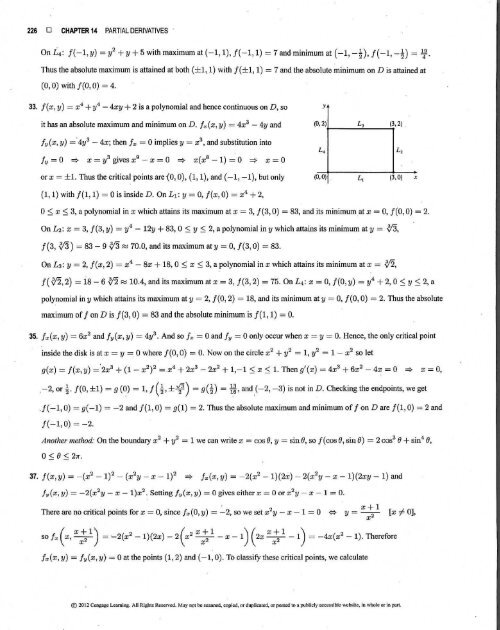Exercicios resolvidos James Stewart vol. 2 7ª ed - ingles
Create successful ePaper yourself
Turn your PDF publications into a flip-book with our unique Google optimized e-Paper software.
226 D CHAPTER 14 PARTIAL DERIVATIVES<br />
On .i4 : f( -1, y) = y 2 + y + 5 with maximum at ( -1, 1 ), f( - 1, 1) = 7 and minimum at ( -1, -D. f( - 1, -~) = Jf.<br />
Thus the absolute maximum is attain<strong>ed</strong> at both (±1, 1) with /(±1, 1) = 7 and the absolute minimum on Dis attain<strong>ed</strong> at<br />
(0, 0) with f(O, 0) = 4.<br />
33. f(x, y) = x 4 +y 4 - 4xy + 2 is a polynomial and hence continuous on D, so Y<br />
it has an absolute maximum and minimum on D. fx(x, y) = 4x 3 -<br />
4y and<br />
(0, 2)+---L--'3'-------1(3, 2) .<br />
fv(x, y) = ·4y 3 -<br />
4x; then f x = 0 implies y = x 3 , and substitution into<br />
fv = 0 => x = y 3 gives x 9 - x = 0 => x(x 8 - 1) = 0 => x = 0<br />
or x = ±1. Thus the critical points are -(0, 0), (1, 1), and ( - 1, - 1), but only<br />
(0,0) (3,0) X<br />
(1, 1) with f(1, 1) = 0 is inside D . On £1: y = 0, f(x, 0) = x 4 + 2,<br />
0 ~ x ~ 3, a polynomial in x which attains its maximum at x = 3, !(3, 0) = 83, and its minimum at x = 0, f (O, 0) = 2.<br />
On £ 2 : x = 3, /(3, y) = y 4 - 12y + 83, 0 ~ y ~ 2, a polynomial in y which attains its minimum at y = {/3,<br />
/(3, {13) = 83- 9 .{/3 ~ 70.0, and its maximum at y = 0, ! (3, 0) = 83.<br />
On L 3 : y = 2, f(x, 2) = x 4 -<br />
Bx + 18, 0 ~ x ~ 3, a polynomial in x which attains its minimum at x = q'2,<br />
f( q'2, 2) = is- 6 ij2 ~ 10.4, and its maximum at x = 3, /(3, 2) = 75. On £ 4: x = 0, f(O, y) = y 4 + 2, 0 ~ y ~ 2, a<br />
polynomial in y which attains its maximum at y = 2, f(O , 2) = 18, and its minimum at y = 0, f(O, 0) = 2. Thus the absolute<br />
maximum off on Dis /(3, 0) = 83 and the absolute minimum is /(1, 1) = 0.<br />
35. f,(x, y) = 6x 2 and fv(x, y) = 4y 3 • And so f x = 0 and fv = 0 only occur when x = y = 0. Hence, the only critical point<br />
.inside the disk is at x = y :::o 0 where /(0, 0) = 0. Now on the circle x 2 + y 2 = 1, y 2 = 1 - x 2 so let<br />
g(x) = f(x, y) =·2x 3 + (1- x 2 ) 2 = .x 4 + 2x 3 - 2x 2 + 1,-1 ~ x ~ 1. Then g'(x) = 4x 3 + 6x 2 - 4~ = 0 => x = 0,<br />
-2, or ~ - /(0,±1) = g(~) = 1, !(~, ±1 ) = g(~) = ~· and ,(-2,-3) is not in D. Checking the endpoints, we get<br />
.f( -1, 0) = g( -1) = -2 and f(1 , 0) = g(1) = 2. Thus the absolute maximum and minimum off on Dare /(1, 0) = 2 and<br />
f(- 1,0) = - 2.<br />
Another method: On the boundary x 2 + y 2 = 1 we can write x = cos (;I, y = sin 8, so f (cos 8, sin 8) = 2 cos 3 8 + sin 4 (;I,<br />
0 ~ () ~ 27T.<br />
37. f(x, y) = - (x 2 - 1) 2 - (x 2 y- x - 1) 2 => f,(x, y) = - 2(x 2 - 1)(2x) - 2(x 2 y- x - 1)(2xy- 1) and<br />
jy(X, y) = -2(x 2 y- x - 1)x 2 . Setting j y(x, y) = 0 gives either x = 0 or x 2 y - x- 1 = 0.<br />
There are no critical points for x = O,.since f:.,(O, y) = .:_2, so we set x 2 y - x- 1 = 0 {:} y = x ~ 1 [x =/= 0],<br />
X<br />
so f, ( x, x~ 1 ) = ·-2(x 2 -<br />
1){2x)- 2(x 2 x ~ 1 - x - 1) (2x x ~ 1 - 1) = -4x(x 2 - 1). Therefore<br />
f,(x, y) = fv(x, y)- = 0 at the points (1, 2) and ( -1, 0). To classifY these critical points, we calculate<br />
® 2012 Cc.ngage Learning. All Rights Rescrvcc.l. MilY not be scann<strong>ed</strong>, copi<strong>ed</strong>, or duplicat<strong>ed</strong>, or postcd'1o n publicly occcssiblo \\'Cb~ite, in \\'hole or in part.


